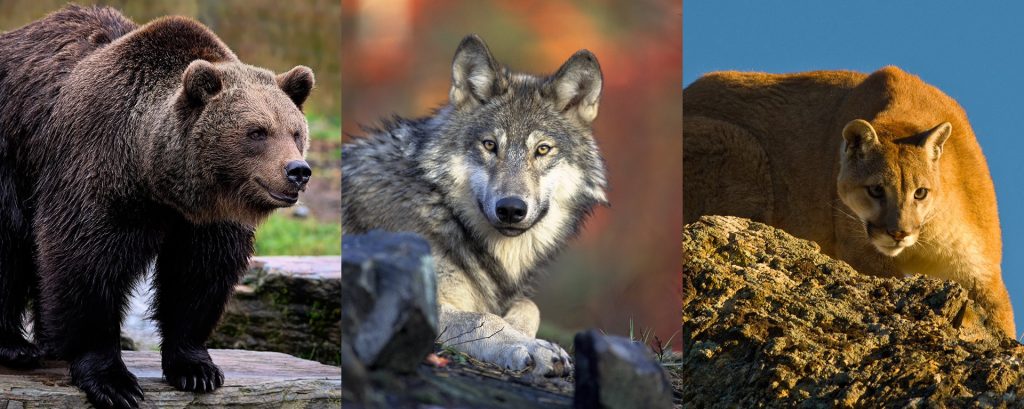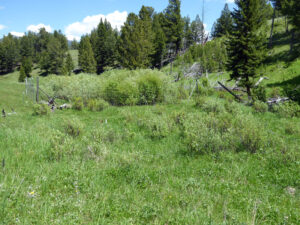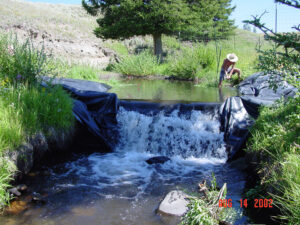
Apex predators not a quick fix for restoring ecosystems, 20-year CSU study finds
Original article by Jayme DeLoss can be found here in CSU Source.

A Colorado State University experiment spanning more than two decades has found that removal of apex predators from an ecosystem can create lasting changes that are not reversed after they return – at least, not for a very long time.
The study, funded by the National Science Foundation and published in Ecological Monographs, challenges the commonly held belief that the reintroduction of wolves to Yellowstone National Park restored an ecosystem degraded by their absence.
Researchers in CSU’s Warner College of Natural Resources examined the effects of three apex predators – carnivores at the top of the food chain not preyed on by other animals – in Yellowstone. Depleted populations of cougars and grizzly bears naturally recovered about the same time wolves were reintroduced to the park in 1995. The absence of these predators for nearly a century transformed the food web and landscape.
Yellowstone’s northern range shifted from willow and aspen stands along small streams with beaver activity to grasslands due to intensive browsing by elk. The widespread changes stabilized into an alternative ecological state that resisted returning to previous conditions once the carnivores were restored, according to authors of the study, Tom Hobbs and David Cooper.
This designed experiment conducted in Yellowstone is the longest of its kind and adds to evidence supporting the theory that degradation of ecosystems may not be reversed when harmful stressors are mitigated.
“When you disturb ecosystems by changing the makeup of a food web, it can lead to lasting changes that are not quickly fixed,” said Hobbs, lead author and professor emeritus with the Department of Ecosystem Science and Sustainability and the Natural Resource Ecology Laboratory. “We can’t rule out the possibility that the ecosystem will be restored over the next 40 years as a result of the return of apex predators. All we can be sure of is what’s observable now — the ecosystem has not responded dramatically to the restored food web.”
Though not a quick and easy solution, Hobbs said, restoration of apex predators produces healthier ecosystems in the long run.
“The conservation message is don’t lose them in the first place,” Hobbs said. “Keep the food web intact, because there’s not a quick fix for losing top predators from ecosystems.”
Can Colorado learn from Yellowstone?
Colorado Parks and Wildlife introduced five wolves to the state Dec. 18 with plans to bring in more in coming years. Wolves were eradicated in the state by the mid-1940s, but Colorado voters approved their restoration by a narrow margin in 2020.
This study may hold lessons about how restoring apex predators affects the ecosystem, but Hobbs said that the environmental degradation resulting from Yellowstone’s policy not to cull elk was never replicated in Colorado.
“Unlike Yellowstone, Colorado’s landscapes have not experienced widespread excessive grazing or browsing from elk,” Hobbs said. “The state has done a good job of managing elk populations using hunting.”
Hobbs and Cooper said there are many good reasons to restore wolves; just don’t expect them to cause immediate ecosystem improvements.
“Our work supports the fact that wolves are important components of ecosystems,” said Cooper, a research scientist emeritus in the Department of Forest and Rangeland Stewardship. “They will have some ecosystem benefits by reducing some large herbivore populations. Over the next hundred years, they’ll have a greater role in regulating some of the ecological processes that we’ve been studying.”
What do willows have to do with wolves?

Wolves and cougars were wiped out in Yellowstone by the early 1920s. Without apex predators or human hunters to control their population, elk fed on the willows along small streams in Yellowstone’s northern range, depleting beavers’ food supply and building materials and causing them to abandon the streams in favor of more suitable areas.
Historically, beavers and willows relied on each other to thrive. Flooding caused by beaver dams created favorable soil moisture conditions for willows, and willows provided food and dam-building materials for beavers. Without beaver-engineered flooding, small streams in the northern range cut deeper into the landscape, disconnecting roots of willows from groundwater. Willows never recovered their former height and density.
Following the reintroduction of wolves to the park in 1995, as cougar and grizzly populations were rebounding on their own, the elk population dropped from both predation and hunting by humans along park borders.
However, overall browsing of woody food sources has not declined proportionally. As the number of elk has decreased, bison herds have increased. Yellowstone’s carnivores typically don’t prey on bison because their large size makes them dangerous.
Long-term experiment

In 2001, CSU ecologists began an experiment to gauge whether the Yellowstone ecosystem would recover due to the restoration of apex predators. They established four study areas in the park’s northern range, fenced off eight plots to prevent browsing and constructed simulated beaver dams in some fenced and non-fenced plots to raise the water table. They also left control areas unaltered. In 2009, they added 21 more control plots to ensure the results of their experiment were representative of the landscape.
If predators regulated the elk population, preventing them from cutting down willows, the landscape would hypothetically return to its previous state. Instead, the willows remained short on control plots, while the fenced sites with simulated dams showed dramatic recovery.
Willows grew more than three times taller in the fenced, dammed areas than in the control plots, indicating the importance of groundwater access in addition to mitigation of browsing.
By manipulating one factor at a time – browsing and hydrology – at many sites for a long time, the researchers were able to show that carnivores were not causing landscape restoration.
“We learned from the science that it was way more complicated,” Cooper said.
“Our result is well supported by ecological theory and empirical results from all over the world,” Hobbs added. “Disturbing food webs can cause persistent changes in ecosystems.”
Research in Yellowstone is common, but this study was rare in its manipulation of the landscape and its duration. Hobbs and Cooper worked closely with park management and biologists, including Yellowstone National Park Senior Wildlife Biologist Daniel Stahler, to answer questions relevant to the park’s needs and share results to help guide park policy.
“This research contributes greatly to our understanding of Yellowstone by teasing out the degree to which complex links in a food web affect ecosystems under native species recovery,” Stahler said. “Importantly, it is among few published studies to date on the Yellowstone ecosystem that highlight that not just wolves, but multiple predator species together have contributed to changes in elk abundance. This point has ramifications for how we evaluate how complex ecosystems respond to carnivore presence and absence.”
He continued, “This long-term research conducted by the CSU team also highlights the value of national parks in helping us understand ecological processes to better protect ecosystems. We should not only cherish our national parks because they protect, preserve and allow people to enjoy nature, but because they provide a place where well-designed science can elevate our understanding of its complexity.”
Check out Tom Hobbs’ interview with 9News here on YouTube.